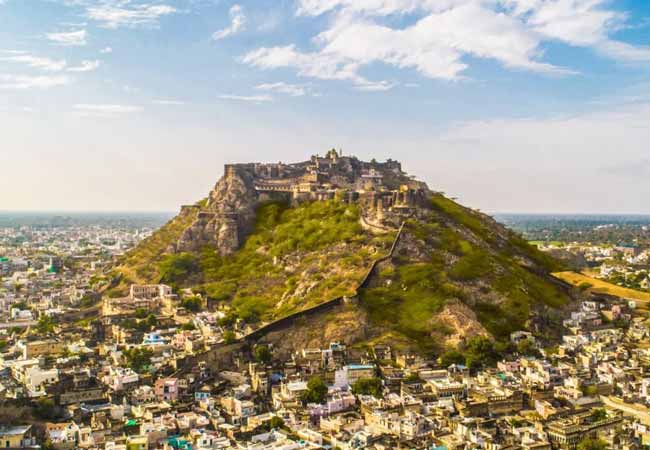Kuchaman City, nestled in the Nagaur district of Rajasthan, India, is a city steeped in history and known for its majestic fort and vibrant culture. Located on the Jaipur-Nagaur route, it’s approximately 145 kilometers from Jaipur and 101 kilometers from Ajmer.
Historical Significance: Kuchaman’s history dates back to the 5th and 8th centuries AD when it was established as a seat for Pratihara dynasty rulers. Over the centuries, it witnessed the rise and fall of various powers, including the Chauhans and Gaurs, before finally being conquered and ruled as a feudal jagir by the Rathores. The most iconic landmark, the Kuchaman Fort, is approximately 1100 years old, built in the 9th century by Rathore ruler Zalim Singh. This formidable structure, perched atop a 1,000-foot-high cliff, served as a strategic stronghold and once housed the entire city within its 32 bastions and ten large gates.
Attractions and Tourism: Today, the Kuchaman Fort is a major tourist draw, having been transformed into a luxurious heritage hotel. It boasts exquisite original inlay work in semi-precious stones, glass, and gold paint, with highlights like the Sheesh Mahal (glass palace). The fort has also served as a backdrop for Bollywood movies like “Jodha Akbar” and “Drona.”
Beyond the fort, Kuchaman City offers other points of interest:
- Meera Mahal: An exquisite palace featuring miniature paintings illustrating the life story of the Rathore poet-saint Meerabai, a passionate devotee of Lord Krishna.
- Jal Mahal: A unique architectural marvel with hidden swimming pools designed for queens and princesses, engineered to control water temperature.
- Sabha Prakash (Illumination Meeting): The formal chambers where kings held court and made critical decisions for public welfare, adorned with polished walls and intricate inlays.
- Lok Dev Temple, Ganesh Dungri, and Shakti Peeth Shakumbhri: Temples showcasing traditional art and paintings, with the Shakumbhri Hill hosting a popular annual fair.
- China Pole: An intriguing structure built by an unknown Chinese traveler to narrate his experiences.
- Havelis: The city also features several Havelis in the Shekhawati style, adorned with beautiful fresco paintings depicting flowers, motifs, and Hindu Mythology.
The best time to visit Kuchaman City is during the winter months, from October to March, when the weather is pleasant for sightseeing.
Demographics and Economy: As of the 2011 India census, Kuchaman City had a population of 81,969, with males constituting 51% and females 49%. The literacy rate was 76.53%, higher than the state average. In 2025, the estimated population of Kuchaman City Municipality is approximately 88,000.
The economy of Kuchaman City is diverse. Historically, it has been largely dependent on agriculture, with crops like wheat, bajra, jowar, pulses, and barley being cultivated. However, it has also emerged as a significant trade center in Rajasthan. Key economic drivers include salt processing, with numerous salt-producing plants and related industries like caustic soda and soda ash manufacturing. Other important sectors contributing to the local economy include cattle feed manufacturing and trade in handloom, handicrafts, and paddy procurement. The establishment of an industrial base by the Rajasthan State Industrial Development and Investment Corporation Limited (RIICO) has further boosted industrial growth in the region, alongside traditional village industries like pottery, blacksmithing, carpentry, and Khadi industries.
